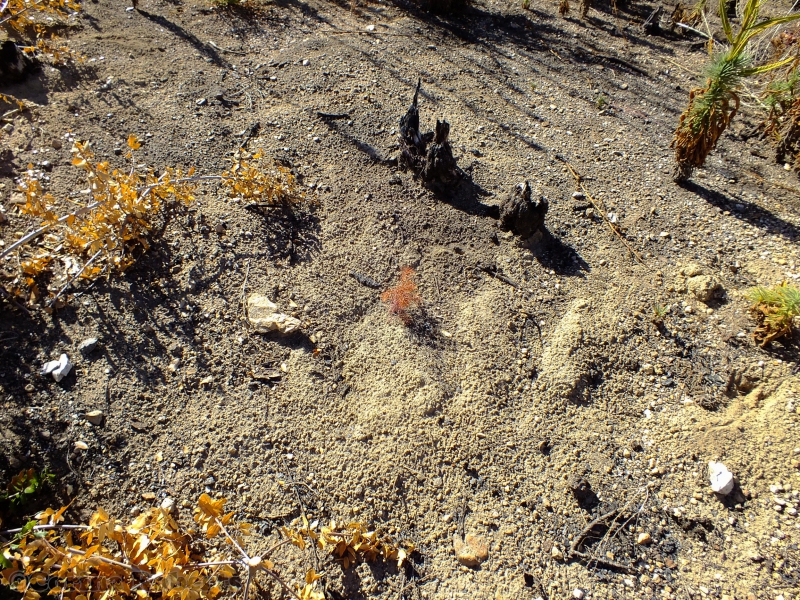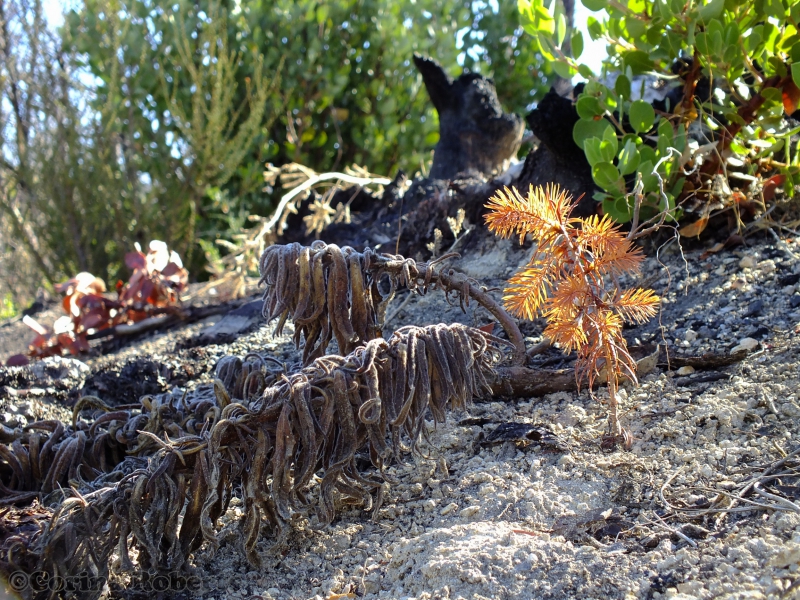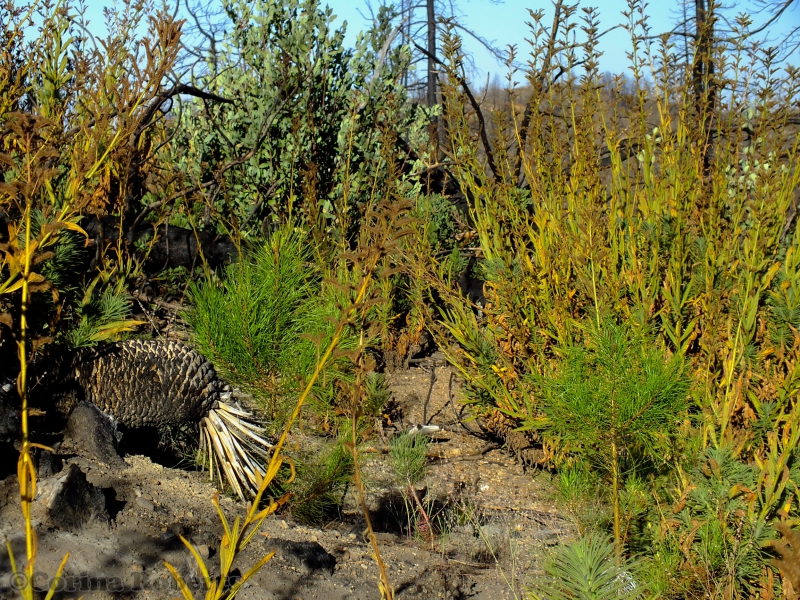From the Open-Publishing Calendar
From the Open-Publishing Newswire
Indybay Feature
Loving Our Trees To Death
Tens of thousands of seedling trees were planted in the Angeles National Forest, and millions of donated dollars support that effort. While it all looked good on paper, the vast majority of the planted trees died, and dysfunctional environmental practices continue to dominate the reforestation effort.
When money can’t buy life -the ongoing failure of reforestation in the Angeles
The three year anniversary of the Station Fire was August 26. I went out this morning, as I have for the last three years, returning to a portion of the forest that was severely burned to chronicle the natural recovery in pictures. The Forest Recovery Project, with nearly 69,000 images in its archive, offers a visual and artistic record of how ecosystems respond to fire.
The Project was intended to illustrate the natural response to fire, but that has become increasingly difficult. In the same locations where the natural recovery is the most vigorous, contractors, volunteers and U.S. Forest Service personnel have forced their own version of recovery on the forest, clear-cutting swaths of native plants in six-foot circles to plant tiny hand-raised seedlings in the barren center.
I visited such a location today, where not once, but two years in a row, efforts to successfully plant new seedlings have had an alarming failure rate.
What I know about planting trees, tree mortality, natural success versus human failure and virtually everything else, I have learned in the process of this documentary effort. I came into the Forest Recovery Project with a double bias. Both Native American people and much of the environmental community understand that fire is in and of itself an integral part of the long term health of natural ecosystems. These are the communities which have shaped my ideas about fire and nature; I expected this beneficial aspect of fire to be proven accurate as I began my task.
That I would be ignorant to many of the nuances of modern forestry is no surprise; I took the stand that we needed to stop imposing our will on the forest and use the fire as an opportunity to learn how nature works.
That the people planting trees would share my ignorance, even surpass it, was shocking. And frustrating. In Charlton Flat, the crown jewel of conifer recovery in all of the Angeles, naturally occurring seedlings were trampled and dug up to plant hand-raised seedlings, imported from somewhere else, which for the most part promptly died, leaving only the circular barren earth and their shriveled little trunks in what had been a fertile bed of natural seedlings.
The hand-planted seedlings are easy to find. Look for circles of parched, barren earth and native vegetation cut and thrown about. You will here and there find a living hand-raised seedling. You will find near it eight more that died.
There’s really no evil villain to wag an accusing finger at, and no scandal to expose, though heaven knows millions of dollars exchanged hands. Hundreds of volunteers on the ground and likely thousands more who donated money for the replanting of the Angeles National Forest in the wake of the Station Fire had only the best of intentions, and desired nothing more than to be a part of the rebirth of the forest. To this day, three years after the fire, the failure of those efforts is still glaring, the man-made scars still obvious.
Opposition always existed for the plan to plant tens of thousands of baby trees in the burn areas. It was over-ridden by both funding and feelings, and probably some well-meaning advice. The Station Fire was the largest in the history of Los Angeles County, burning 160,577 acres, most of that in the forest. It took homes and lives. It was a fire that might have been extinguished before it became the massive wall of flame that threatened homes from Acton to Arcadia; a point that would not have been so controversial if only the forest had burned.
There was a tremendous amount of public sentiment that the U.S. Forest Service had better do something to fix the mess they were being blamed for. Tree People began collecting donations while the fire still raged, and people gave. Chevron would offer the USFS five million dollars to plant trees for carbon offset for their El Segundo facility. The momentum in favor of planting - and the sheer feel-good appeal of healing the forest - easily overshadowed the nay-sayers, those fussy environmentalist-elites.
I was one of the minority, opposed to planting. I lived in the forest, I was documenting the recovery that began before there was rain, before the fire was contained. My belief was that the only thing we needed to do as human beings was let Nature teach us how to heal.
That’s not to say I don’t like planting trees. Nor is it to say I’m against planting trees. It just didn’t need to be done in the forest, and it definitely did not need to be done in response to the fire. Certainly, I would not want to deprive anyone of the joy of planting trees. So when, in the summer of 2010, the volunteers arrived, eager to plant, I simply avoided them. They would soon learn what I was learning; naturally occurring seedlings would begin emerging from the forest floor in June, and by late July there would be countless thousands of them.
Tree People would counter the resistance to tree planting projects by explaining that trees would only be planted in areas of the forest that were not capable of recovering on their own. Over time it would become evident that there was no area in the forest incapable of self-generated recovery. What was taking place was natural succession;
the emergence of plants, beginning with microorganisms and the smallest species, the annual fire followers and the fire-adapted species, then larger shrubs and plants, and finally, the largest organisms in the forest, the trees.
The philosophy in place was that trees had to be planted as soon as possible so they could compete for water and sunlight with faster-growing plants. To this theory countless thousands of seedlings were marched to their death.
Eventually, the planting crews marched on into regions where seedlings might have a better chance of survival; where they would be placed in the company of a living carpet of existing seedlings.
Here, in these fertile seedling nurseries, planters encountered other plants, like the poisonous Poodle Dg Bush. Failing to acknowledge the symbiosis of living things to each other, the slash and clear policy continued with a particular vengeance toward the Poodle Dog Bush. By the second post-fire year it was obvious that this fire follower had much in the way of protection and optimum growth conditions to offer the seedling trees, but that relationship failed to impress anyone enough to get them to stop cutting it down. In the spring of 2012, in one of the most fertile seedling beds in the Charlton Flat region, Poodle Dog Bush was cut away so that a second round of hand-planted seedlings could join the healthy natural ones, and the dead from the previous planting efforts.
As I walked about this morning I had mixed emotions, viewing both recovery and recurring errors in a steep and arid bit of forest, dominated by manzanita, Poodle Dog Bush and ceanothus, and formerly, mature conifer trees. It is a slope and ravine visible from Highway 2, and the standing dead conifers bear witness to the intensity of the fire here. For many months after the fire, this area remained black and lifeless.
Two tree planting efforts took place here. The second has been marginally more successful than the first, but the credit for that is not human. The plant communities that shelter and support the seedlings have had a chance to rebound from the fire. They offer shade and moisture now that the first batch of seedlings did not have. Sadly, the planting methods are the same, and indeed, the second batch of seedlings were planted in the same barren, eroding circles as their dead predecessors.
They were easy to find, evidenced by cut manzanita branches laying dead upon the ground, uprooted Poodle Dog Bush, and large areas of exposed soil which stand out in stark contrast to the natural vegetation pattern.
The tree planters, it appears, still haven’t really learned much. Nature will have to prevail in spite of our best efforts.
(The Forest Recovery Project is shared as a powerpoint/keynote presentation on a donation basis throughout southern California, created by the non profit association Redbird with special permission for limited access to burn areas, some of which remain closed to the public, and technical assistance of the U.S. Forest Service, Angeles National Forest).
The three year anniversary of the Station Fire was August 26. I went out this morning, as I have for the last three years, returning to a portion of the forest that was severely burned to chronicle the natural recovery in pictures. The Forest Recovery Project, with nearly 69,000 images in its archive, offers a visual and artistic record of how ecosystems respond to fire.
The Project was intended to illustrate the natural response to fire, but that has become increasingly difficult. In the same locations where the natural recovery is the most vigorous, contractors, volunteers and U.S. Forest Service personnel have forced their own version of recovery on the forest, clear-cutting swaths of native plants in six-foot circles to plant tiny hand-raised seedlings in the barren center.
I visited such a location today, where not once, but two years in a row, efforts to successfully plant new seedlings have had an alarming failure rate.
What I know about planting trees, tree mortality, natural success versus human failure and virtually everything else, I have learned in the process of this documentary effort. I came into the Forest Recovery Project with a double bias. Both Native American people and much of the environmental community understand that fire is in and of itself an integral part of the long term health of natural ecosystems. These are the communities which have shaped my ideas about fire and nature; I expected this beneficial aspect of fire to be proven accurate as I began my task.
That I would be ignorant to many of the nuances of modern forestry is no surprise; I took the stand that we needed to stop imposing our will on the forest and use the fire as an opportunity to learn how nature works.
That the people planting trees would share my ignorance, even surpass it, was shocking. And frustrating. In Charlton Flat, the crown jewel of conifer recovery in all of the Angeles, naturally occurring seedlings were trampled and dug up to plant hand-raised seedlings, imported from somewhere else, which for the most part promptly died, leaving only the circular barren earth and their shriveled little trunks in what had been a fertile bed of natural seedlings.
The hand-planted seedlings are easy to find. Look for circles of parched, barren earth and native vegetation cut and thrown about. You will here and there find a living hand-raised seedling. You will find near it eight more that died.
There’s really no evil villain to wag an accusing finger at, and no scandal to expose, though heaven knows millions of dollars exchanged hands. Hundreds of volunteers on the ground and likely thousands more who donated money for the replanting of the Angeles National Forest in the wake of the Station Fire had only the best of intentions, and desired nothing more than to be a part of the rebirth of the forest. To this day, three years after the fire, the failure of those efforts is still glaring, the man-made scars still obvious.
Opposition always existed for the plan to plant tens of thousands of baby trees in the burn areas. It was over-ridden by both funding and feelings, and probably some well-meaning advice. The Station Fire was the largest in the history of Los Angeles County, burning 160,577 acres, most of that in the forest. It took homes and lives. It was a fire that might have been extinguished before it became the massive wall of flame that threatened homes from Acton to Arcadia; a point that would not have been so controversial if only the forest had burned.
There was a tremendous amount of public sentiment that the U.S. Forest Service had better do something to fix the mess they were being blamed for. Tree People began collecting donations while the fire still raged, and people gave. Chevron would offer the USFS five million dollars to plant trees for carbon offset for their El Segundo facility. The momentum in favor of planting - and the sheer feel-good appeal of healing the forest - easily overshadowed the nay-sayers, those fussy environmentalist-elites.
I was one of the minority, opposed to planting. I lived in the forest, I was documenting the recovery that began before there was rain, before the fire was contained. My belief was that the only thing we needed to do as human beings was let Nature teach us how to heal.
That’s not to say I don’t like planting trees. Nor is it to say I’m against planting trees. It just didn’t need to be done in the forest, and it definitely did not need to be done in response to the fire. Certainly, I would not want to deprive anyone of the joy of planting trees. So when, in the summer of 2010, the volunteers arrived, eager to plant, I simply avoided them. They would soon learn what I was learning; naturally occurring seedlings would begin emerging from the forest floor in June, and by late July there would be countless thousands of them.
Tree People would counter the resistance to tree planting projects by explaining that trees would only be planted in areas of the forest that were not capable of recovering on their own. Over time it would become evident that there was no area in the forest incapable of self-generated recovery. What was taking place was natural succession;
the emergence of plants, beginning with microorganisms and the smallest species, the annual fire followers and the fire-adapted species, then larger shrubs and plants, and finally, the largest organisms in the forest, the trees.
The philosophy in place was that trees had to be planted as soon as possible so they could compete for water and sunlight with faster-growing plants. To this theory countless thousands of seedlings were marched to their death.
Eventually, the planting crews marched on into regions where seedlings might have a better chance of survival; where they would be placed in the company of a living carpet of existing seedlings.
Here, in these fertile seedling nurseries, planters encountered other plants, like the poisonous Poodle Dg Bush. Failing to acknowledge the symbiosis of living things to each other, the slash and clear policy continued with a particular vengeance toward the Poodle Dog Bush. By the second post-fire year it was obvious that this fire follower had much in the way of protection and optimum growth conditions to offer the seedling trees, but that relationship failed to impress anyone enough to get them to stop cutting it down. In the spring of 2012, in one of the most fertile seedling beds in the Charlton Flat region, Poodle Dog Bush was cut away so that a second round of hand-planted seedlings could join the healthy natural ones, and the dead from the previous planting efforts.
As I walked about this morning I had mixed emotions, viewing both recovery and recurring errors in a steep and arid bit of forest, dominated by manzanita, Poodle Dog Bush and ceanothus, and formerly, mature conifer trees. It is a slope and ravine visible from Highway 2, and the standing dead conifers bear witness to the intensity of the fire here. For many months after the fire, this area remained black and lifeless.
Two tree planting efforts took place here. The second has been marginally more successful than the first, but the credit for that is not human. The plant communities that shelter and support the seedlings have had a chance to rebound from the fire. They offer shade and moisture now that the first batch of seedlings did not have. Sadly, the planting methods are the same, and indeed, the second batch of seedlings were planted in the same barren, eroding circles as their dead predecessors.
They were easy to find, evidenced by cut manzanita branches laying dead upon the ground, uprooted Poodle Dog Bush, and large areas of exposed soil which stand out in stark contrast to the natural vegetation pattern.
The tree planters, it appears, still haven’t really learned much. Nature will have to prevail in spite of our best efforts.
(The Forest Recovery Project is shared as a powerpoint/keynote presentation on a donation basis throughout southern California, created by the non profit association Redbird with special permission for limited access to burn areas, some of which remain closed to the public, and technical assistance of the U.S. Forest Service, Angeles National Forest).
For more information:
http://www.RedbirdsVision.org
Add Your Comments
Latest Comments
Listed below are the latest comments about this post.
These comments are submitted anonymously by website visitors.
TITLE
AUTHOR
DATE
US Monoculture Service
Wed, Sep 12, 2012 10:42PM
We are 100% volunteer and depend on your participation to sustain our efforts!
Get Involved
If you'd like to help with maintaining or developing the website, contact us.
Publish
Publish your stories and upcoming events on Indybay.
Topics
More
Search Indybay's Archives
Advanced Search
►
▼
IMC Network







